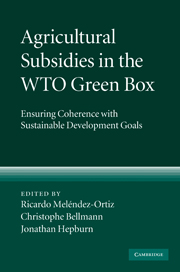Book contents
- Frontmatter
- Contents
- List of contributors
- Preface
- Acknowledgements
- List of abbreviations
- 1 Overview
- PART I The recent evolution of agricultural trade policy reform
- 2 The historical context of the green box
- 3 Doha Round negotiations on the green box and beyond
- 4 The reform of the EU's Common Agricultural Policy
- 5 Farm policy reform in the United States: past progress and future direction
- 6 Agricultural trade policy reform in Japan
- PART II The focus, extent and economic impact of green box subsidies
- PART III Green box subsidies and developing countries
- PART IV Green box subsidies and the environment
- PART V Looking forward: how can change take place?
- Appendix: Text of Annex 2 of the WTO Agreement on Agriculture (“the green box”)
- Index
- References
5 - Farm policy reform in the United States: past progress and future direction
from PART I - The recent evolution of agricultural trade policy reform
Published online by Cambridge University Press: 03 May 2010
- Frontmatter
- Contents
- List of contributors
- Preface
- Acknowledgements
- List of abbreviations
- 1 Overview
- PART I The recent evolution of agricultural trade policy reform
- 2 The historical context of the green box
- 3 Doha Round negotiations on the green box and beyond
- 4 The reform of the EU's Common Agricultural Policy
- 5 Farm policy reform in the United States: past progress and future direction
- 6 Agricultural trade policy reform in Japan
- PART II The focus, extent and economic impact of green box subsidies
- PART III Green box subsidies and developing countries
- PART IV Green box subsidies and the environment
- PART V Looking forward: how can change take place?
- Appendix: Text of Annex 2 of the WTO Agreement on Agriculture (“the green box”)
- Index
- References
Summary
Introduction
Toward the end of its first decade, a chaotic environment shaped US farm policies for the twenty-first century. Exchange rates had realigned significantly over the past decade, yet they remained skewed globally compared to levels that might be necessary for sustainable balanced trade. There had been five years of disastrous expansion of armed conflict in the Middle East, with collateral effects on world oil prices. No one could confidently disentangle proximate short-term from longer-term supply and demand determinants to say for certain where oil prices might settle. The occurrence of global warming was broadly recognized even within resistant circles in the US, but what was to be done about it? The call for greater energy self-sufficiency (called “security”, of course) was flying high politically, but was it a viable economic strategy? Questions arose in these circumstances about the traditional assumptions in agricultural policy deliberations that farm prices will often be low and that developed-country subsidies will drive them down further.
In this chaotic environment, the US Congress wrote a new farm bill in 2008. The prospect of whether or not there would be a multilateral Doha Round WTO agreement simmered in the background, but the domestic farm bill debate paid little attention to multilateral rules or constraints. Bioenergy enthusiasm (and subsidies) fuelled market optimism. Crop prices were relatively high after 2005, as they were briefly in 1995 to 1996, then shot up in 2008, with projections for continuation of high prices through the decade.
- Type
- Chapter
- Information
- Agricultural Subsidies in the WTO Green BoxEnsuring Coherence with Sustainable Development Goals, pp. 86 - 120Publisher: Cambridge University PressPrint publication year: 2009



